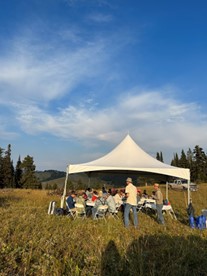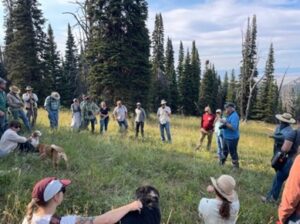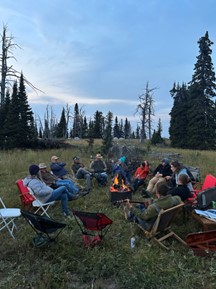Progress report for WID24-001
Project Information
This grant will fund sustainable agriculture practices and research throughout the state of Idaho. The goal of this three-year funding cycle is to spread these funds to all areas of Idaho’s sustainable agriculture system to garner knowledge and share results with farmers and ranchers. Many producers and research faculty in Idaho are conducting great sustainable agriculture research in all corners of our state and we would like to give more opportunities for these groups to dive deeper into their sustainable agriculture practices and be able to share what they learn. This is why we plan to make a greater effort in getting the word about SARE out to more organizations.
We plan to support projects that investigate the use of cover crops in new and inventive ways. Increase our support in rangeland management by attending and promoting SARE at more rangeland centered programs and meetings. We will continue to support many of the small farmer/rancher programs that have been supported in the past as well as continued support of the Regenerative ranching conferences. We will also increase our outreach to more farmers and ranchers that may want to travel to national conferences by offering them travel grant support.
The main objective of the three-year program will be to increase the ability of Idaho producers to implement sustainable agriculture practices on their farms and ranches. We will increase knowledge of what sustainable practices are in Idaho and how best to implement them on your farm or ranch. We will increase the capacity of University of Idaho Extension Educators to conduct field research and perform other necessary programs by offering research and travel reimbursements. Training for increased community involvement in sustainable agriculture practices. We will continue our involvement with the University of Idaho’s small farmer educational program, Cultivating Success, and with a team working with beginning farmers and ranchers. We will continue to support local producers, connect with buyers and plan their production accordingly. This will improve access to local foods and improve profitability for producers. Funds will be used for training and support staff.
We will also continue to support professional development opportunities for Extension professionals and others working in sustainable agriculture, including support for research and travel to conferences for professional development in sustainable agriculture. We will also use the funds to travel to annual SARE PDP meetings.
Sustainability in agriculture is a constantly moving target. Keeping up with new practices to enhance sustainability in your operation can feel like a game of catch up. There are always new farming practices, new products or new ways to market that are said to increase profits, decrease erosion or enhance you and your employees’ standard of living. The goal of Idaho’s state implementation program is to allow producers and educators throughout the state to test out these new methods or attend a class or conference to increase their knowledge on new and upcoming practices. In addition, we support conferences and programs within the state that teach sustainability practices or host meetings that allow producers to share ideas on relevant sustainable agriculture topics.
In a recent meeting with the SARE advisory committee they supported the continuation of the cost reimbursement mini-grant program we have implemented throughout the past few years. They agree that this program gives multiple groups throughout the state the access to test out and learn more about sustainable agriculture practices that they may not have had the time or funds to test out without the program. When reviewing the projects that have been funded over the past three years, they agreed the diversity of those implemented was impressive and agreed they all met the standards of sustainability.
Projects that are likely to be covered in the next three years would be continued research on corn silage planter row width and cover crop incorporation into standing corn silage. Use of new technology such as drones and virtual reality systems to teach sustainable practices to producers. Regenerative ranching conferences to increase knowledge and networking with Idaho’s ranching community. Rotational grazing for small ruminants on research centers and producers’ operations. Increasing education opportunities on butchery and meat processing to increase the workforce needed to meet the production of Idaho’s agriculture industry.
Through this program we will be able to make sustainable practices in Idaho more visible to the public and producers alike. We will share the information gathered from these projects and conference attendees to producers in Idaho to increase networking and knowledge of sustainable agriculture in Idaho. To ensure the success of this program we will continue to ask for guidance from our Advisory committee and producers across the state.
2024 Timeline
February 2024 – Advertise spring mini-grant application openings for travel and project support.
March 2024 – Announce grant award winners and distribute funds. Deadline to turn in receipts is October 30, 2024.
June 2024 – Attend Western SARE State coordinators annual meeting.
August – Check with Mini-grant recipients on funds and project completion. Reminder that grant spending closes on October 30, 2024.
September – Host Annual Advisory committee meeting
September – Advertise fall/winter mini-grant application openings for travel and project support.
October – Announce grant award winners and distribute funds. Deadline to turn in receipts is March 30, 2025.
2025 Timeline
January – Check with Mini-grant recipients of the fall/winter grants on funds and project completion. Reminder that grants spending closes on March 30, 2025.
March 2025 - Announce grant award winners and distribute funds. Deadline to turn in receipts is October 30, 2025.
June 2025 – Attend Western SARE State coordinators annual meeting.
August – Check with Mini-grant recipients on funds and project completion. Reminder that grants spending closes on October 30, 2025.
September – Host Annual Advisory committee meeting
September – Advertise fall/winter mini-grant application openings for travel and project support.
October – Announce grant award winners and distribute funds. The deadline to turn in receipts is March 30, 2026.
2026 Timeline
January – Check with Mini-grant recipients of the fall/winter grants on funds and project completion. Reminder that grants spending closes on March 30, 2026.
March 2026 - Announce grant award winners and distribute funds. Deadline to turn in receipts is October 30, 2026.
June 2026 – Attend Western SARE State coordinators annual meeting.
August – Check with Mini-grant recipients on funds and project completion. Reminder that grants spending closes on October 30, 2026.
September – Host Annual Advisory committee meeting
Finalize three-year grant report.
Advisors
- (Educator)
Education
To increase the awareness of the Idaho SARE PDP program a presentation was made at the IACAA meeting in June by state coordinators Carmen and Grant on the history of the Idaho SARE program and opportunities for educators and farmers and ranchers across the state. Other sustainable agriculture trainings supported by the PDP program this year were an in person and zoom training on incorporating ICLS into Idaho cropping systems as well as extension field day to demonstrate the differences between drilling and broadcasting cover crops in the Magic Valley. A Pest Friends training was hosted at the Extension Annual Conference. In addition, a multiweek class was offered on Ranch Succession to aid multigenerational ranches in how best to make hard decisions as they transition their ranches to the next generation.
Education & Outreach Initiatives
That families will begin the process of planning for succession by utilizing the participant notebook and begin to have family meetings about succession.
The 2022 Agriculture Census data shows that nationwide, the average of ranchers/farmers is 57.5 years old and only 9% of producers are under the age of 35. In Idaho, the average age is 56.6 years old. Of the 43,333 producers in Idaho, only 3,859 identified as young producers. Idaho producers over the age of 55 number 25,243. This indicates a need for ranch/farm succession planning if Idaho is to maintain its agricultural economy, businesses, and open spaces. An introduction to succession planning was one of the workshops at Cattlemen’s Winter School in January. At that time, many producers indicated interest in a more comprehensive workshop.
Different survey questions were posted at the beginning of weeks two and three. When asked about some of the challenges faced by the successors coming back, communication was the challenge most mentioned by both classes. The second challenge mentioned was the family members followed by buy-in for new and different ideas. Challenges faced by the owner/operator generation included letting loose of the reins, not having a purpose and deciding who should make management decisions.
In January 2025, participants completed another survey. For the April class, this was eight months after the workshop and for the November class, two months after. When asked to list three things most valuable to them about the workshop, understanding personalities ranked first and how to start the conversation was second. Of those completing the survey 63% responded yes that they had started the conversation. They had also formed a vision for the ranch and gathered documents and visited with a professional.
• Provide education about new and improved sustainable techniques on ICLS in agriculture to agricultural professionals in Idaho.
• Coordinate the ICLS farm tour to enhance understanding of ICLS and provide a platform for growers to interact and be informed about new management systems in agriculture.
The Integrated Crop-Livestock System (ICLS) initiative aims to foster sustainable agricultural practices in Idaho by integrating crop and livestock systems. This project addresses the pressing need for a resilient and productive agricultural system in response to changing market demands, environmental challenges, and the need for improved sustainability.
Globally, ICLS has emerged as a viable strategy for enhancing agricultural sustainability, particularly in the Global South. In North America, challenges such as low biodiversity, intensive inputs, and stagnant yields from monocultures underscore the necessity for innovative solutions. Research indicates that integrating livestock with cropping systems can enhance soil health, diversify crop rotations, and improve overall farm resilience (Abigail et al., 2023).
ICLS could aid producers looking to diversify their operations by incorporating small livestock enterprises in identifying strategies that will help improve soil quality and health, manage pests, diseases, and weeds, and reduce economic risks. In the United States, raising livestock and crops together is an old practice in farming, yet increased specialization in farm production is noticed because of presumed management efficiency. Research suggests integrating animals into crop production systems yields considerable benefits with effective management techniques. However, producers are aware of grazing and its benefits on soil health and productivity, information, and knowledge on region-specific cover crops, and management techniques for grazing cropland is the quest. Managed grazing and crop rotation techniques work best with this approach to avoid over-compaction of the soil can be counted as one of the many benefits of ICLS. Adopting ICLS includes effective management strategies to achieve benefits from the system. ICLS provides long-term benefits, offsets costs, increases livestock density and builds overall soil health and crop productivity. There is a current knowledge gap in the management of cover crops and grazing among agriculture professionals and growers of the region. Fostering region-specific educational initiatives on ICLS is the need of the hour. This proposed project is an initiative to establish and improve platforms to bridge the knowledge gap and promote a more informed and engaged community around ICLS in Idaho Agriculture.
Workshop Insights:
- ICLS Workshop for Ag Professionals (May 15, 2024, Hybrid mode with 29 participants)
Prior to the workshop, participants were surveyed on their perceptions of sustainability in agriculture. Key responses highlighted a need for more productive, sustainable, and climate-resilient agricultural practices. Participants emphasized the potential of leveraging livestock within cropping systems to enhance sustainability and soil health.
Components of ICLS discussed in the workshop with eminent speakers of the region.
The following components were identified as critical to successful ICLS implementation:
- Crop Rotations
- Cover Crops (Forage/Grazing)
- Grazing Crop Residues
- Intercropping
- Dual Purpose Crops (e.g., Winter Wheat)
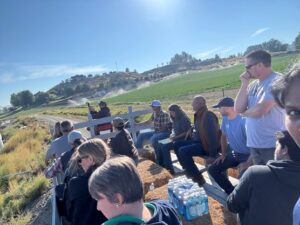
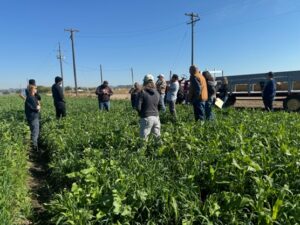
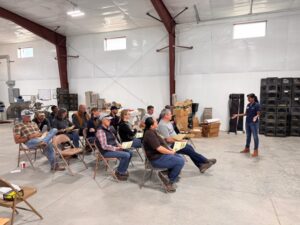
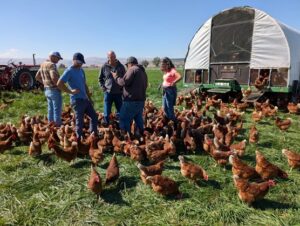
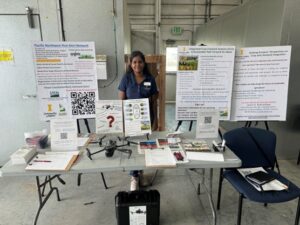
Opportunities and Barriers
While the potential benefits of ICLS are clear, challenges remain. Most crop producers express little interest in integrating livestock, although those already involved in livestock production are more open to incorporating crop-livestock systems.
Outreach Initiatives
The following outreach initiatives were conducted to promote ICLS in Idaho:
- ICLS Field Day and Farm Tour (September 19, 2024, at McIntyre Farms, Caldwell, Idaho with 20 Participants)
Awareness and Outreach Events
o Field Days
o Annual Meetings
o Focus Group Discussions
o Regional Conferences
These events aimed to understand the benefits and barriers to adopting ICLS within the Idaho farming community. Participants included agricultural educators, crop and livestock farmers, and other stakeholders
Conclusion
By integrating crops and livestock, we aim to cultivate not only the soil but also the resilience of our farms and the vitality of our environment. The ongoing outreach and education efforts will continue to support Idaho's agriculture in adopting sustainable practices that contribute to the future of agriculture.
Rangelands are complex systems where multiple societal actors seek out different goals. Bringing these diverse viewpoints together through science is an important goal of co-produced research, which is meant to include the public in all phases of the research. The purpose of this project was to host a public stakeholder tour at the US Sheep Experiment Station through a partnership between University of Idaho and the USDA-ARS in Dubois, Idaho. The project aimed to support a new co-produced research effort. Our broad goals were to 1) disseminate recent University and ARS research to producers, conservation organizations, and land managers; 2) initiate new social networks among diverse partners that will support research co-production at the US Sheep Experiment Station and; 3) identify key research needs for rangeland economics.
We hosted an extension outreach meeting and tour at the US Sheep Experiment Station August 8-9, 2024. The project included a tour of the properties and current collaborative research ongoing between U of I researchers and ARS, as well as research talks from researchers and partners. This included research on: sheep genetics, livestock nutrition, fire and grazing on rangelands, camera trap and other technologies on rangelands, and social science. The event included discussions of rangeland economic research and outreach needs, as well as feedback from participants about how to develop a future collaborative grazing experiment inclusive of economic, social, biodiversity and livestock goals. The event included tour stops across the sagebrush rangelands and high elevation grazinglands used by the Sheep Station in the Centennial Mountains. The meeting concluded with a meal and camp-out, followed by an optional hiking tour the following day to further explore the rangeland systems on the property.
One of the desired outcomes of this project was to “Foster trust and collaboration among diverse group of stakeholders on rangelands in East Idaho”. Within our group of participants we had the expected crowd of federal agency representatives and ranchers, but we also made an effort to invite and include non-profits, some of whom feel very strongly against livestock use on public lands. This event got these participants out on the landscape talking about issues and learning about the on-going science that is occurring. We also observed that participants were also more willing to express more contentious opinions than we had ever been able to extract during our more “formal” indoor meetings. These opinions led to really good group discussion which led to progress on our second objective, Identifying common goals for land stewardship and co-produced research in East Idaho.
The aim of this project is to use AI to develop a prototype that allows the end users monitoring the populations of this beetle in their hop yards.
Effective pest monitoring in agriculture involves overcoming challenges related to identification and detection, monitoring techniques, environmental variability, economic constraints, integration with pest management strategies, biological and behavioral factors, technological adoption, regulatory compliance, and ecological interactions. Addressing these challenges requires a combination of scientific research, technological innovation, farmer education, and collaborative efforts among stakeholders.
The hop industry in the Pacific Northwest is facing increasing concerns on pest control, especially regarding new ways to monitor recurrent insect pests that feed on the root system. This is not the exception in Idaho, where the California Rood Borer (Prionus californicus) is perhaps the less understood insect pest. Predicting the populations of this beetle on hopyards has long relied on pheromone traps that attract adults. However, this is by far the most impractical method as the traps are set underground and revised every day to count the number of individuals inside.
With the development of new technologies using Artificial Intelligence (AI) systems, some smart solutions can become reality and save a lot of time, effort and money for the farmers. Although there are a few companies (both US based and non-US based) offering smart traps and AI solutions for agricultural pests, none of them has designed a system focus on P. californicus.
Overall, we were successful in developing the prototype of the monitor system designed to provide reliable real-time data from multiple Prionus Beetle traps in the field. Using solar power and a system of monitors and a receiver, we bring data from traps to any number of local devices. The data collected will help to build AI and inform growers when the traps should be emptied.
The project was presented during the field day at the Parma Research and Extension Center (August 2024). A total of 70 participants attended, including farmers, stakeholders, educators, faculty, and the general public. We showed the prototype and explained its potential use for farmers, specifically hop growers. During the display, we also distributed flyers with more details of the trap/sensor system, and we provided contact information in case more people wanted to reach out.
This project definitely attracted the attention of growers willing to automate tasks in their farms and save resources. The decision-making could directly impact as the ultimate goal of this technology is to receive the information (i.e., variation of beetle population across time) and then be able to take actions. This information will also build accurate knowledge on the biology of the Prionus beetle.

